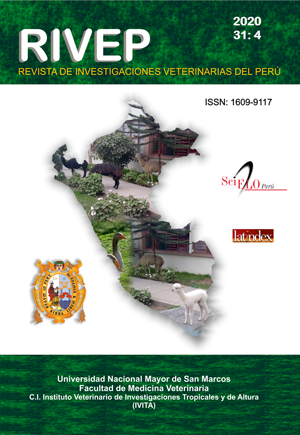Multi-species allometric models to predict biomass in tropical high Andean grasslands
DOI:
https://doi.org/10.15381/rivep.v31i4.19034Keywords:
allometry, basal diameter, canopy diameter, grass, grasslandAbstract
The models of growth and allometry of grasslands allow to know growth and development phenomena. Consequently, the aim of this study was to develop a multi-species allometric model to estimate biomass in three grasses in the High Andean Zone of Jauja, Peru, at an altitude of 3600 m above sea level. The native grasses were Festuca dolichophylla (J. Presl) tall (50-90 cm), Festuca humilior (Nees & Meyen) medium (20-35 cm) and Calamagrostis vicugnarum (Weddell) Pilger short (5- 25 cm). The measured variables were biomass (g, YB), basal diameter (cm, XD), canopy diameter (cm, XC) and height (cm, XH). The potential regression was used by choosing the strength of the models by the Akaike criterion (IAC) and the adjusted coefficient of determination (adjusted R2). The multispecies allometric model was Y = 1,238 * XD2,231, due to its lower IAC (383.795) and higher adjusted R2 (85.4%). C. vicugnarum (Weddell) Pilger had an effect on the multi-species model based on the basal diameter. The multi-species model in F. dolichophylla (J. Presl) shows average estimates at 37% below the individual model. The explanatory variable of basal diameter has greater modelling strength for native grass grasses. It should also be considered that the height of the flag leaf had a greater strength than the diameter of the canopy. The multispecies allometric models allowed to increase the predictive strength in species of high, medium and low size; however, the behaviour of the slope in C. vicugnarum (Weddell) Pilger and the multispecies and individual model relationship in F. dolichophylla (J. Presl) must be considered.
Downloads
Downloads
Published
Issue
Section
License
Copyright (c) 2020 Fritz Carlos Trillo Zárate, Cecilio Barrantes Campos, Gelver Romero Delgado, Edson Tito Quispe, Pamela Quiroga Espilco, Jimny Nuñez Delgado

This work is licensed under a Creative Commons Attribution-NonCommercial-ShareAlike 4.0 International License.
AUTHORS RETAIN THEIR RIGHTS:
a. Authors retain their trade mark rights and patent, and also on any process or procedure described in the article.
b. Authors retain their right to share, copy, distribute, perform and publicly communicate their article (eg, to place their article in an institutional repository or publish it in a book), with an acknowledgment of its initial publication in the Revista de Investigaciones Veterinarias del Perú (RIVEP).
c. Authors retain theirs right to make a subsequent publication of their work, to use the article or any part thereof (eg a compilation of his papers, lecture notes, thesis, or a book), always indicating the source of publication (the originator of the work, journal, volume, number and date).



